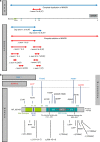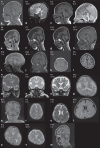The phenotypic spectrum of WWOX-related disorders: 20 additional cases of WOREE syndrome and review of the literature
- PMID: 30356099
- PMCID: PMC6752669
- DOI: 10.1038/s41436-018-0339-3
The phenotypic spectrum of WWOX-related disorders: 20 additional cases of WOREE syndrome and review of the literature
Erratum in
-
Correction: The phenotypic spectrum of WWOX-related disorders: 20 additional cases of WOREE syndrome and review of the literature.Genet Med. 2019 Jul;21(7):1667-1671. doi: 10.1038/s41436-019-0460-y. Genet Med. 2019. PMID: 30783266 Free PMC article.
Abstract
Purpose: Germline WWOX pathogenic variants have been associated with disorder of sex differentiation (DSD), spinocerebellar ataxia (SCA), and WWOX-related epileptic encephalopathy (WOREE syndrome). We review clinical and molecular data on WWOX-related disorders, further describing WOREE syndrome and phenotype/genotype correlations.
Methods: We report clinical and molecular findings in 20 additional patients from 18 unrelated families with WOREE syndrome and biallelic pathogenic variants in the WWOX gene. Different molecular screening approaches were used (quantitative polymerase chain reaction/multiplex ligation-dependent probe amplification [qPCR/MLPA], array comparative genomic hybridization [array-CGH], Sanger sequencing, epilepsy gene panel, exome sequencing), genome sequencing.
Results: Two copy-number variations (CNVs) or two single-nucleotide variations (SNVs) were found respectively in four and nine families, with compound heterozygosity for one SNV and one CNV in five families. Eight novel missense pathogenic variants have been described. By aggregating our patients with all cases reported in the literature, 37 patients from 27 families with WOREE syndrome are known. This review suggests WOREE syndrome is a very severe epileptic encephalopathy characterized by absence of language development and acquisition of walking, early-onset drug-resistant seizures, ophthalmological involvement, and a high likelihood of premature death. The most severe clinical presentation seems to be associated with null genotypes.
Conclusion: Germline pathogenic variants in WWOX are clearly associated with a severe early-onset epileptic encephalopathy. We report here the largest cohort of individuals with WOREE syndrome.
Keywords: WWOX; encephalopathy; epilepsy.
Conflict of interest statement
The authors declare no conflicts of interest.
Figures



References
-
- Bednarek AK, Laflin KJ, Daniel RL, Liao Q, Hawkins KA, Aldaz CM. WWOX, a novel WW domain-containing protein mapping to human chromosome 16q23.3-24.1, a region frequently affected in breast cancer. Cancer Res. 2000;60:2140–2145. - PubMed
-
- Abdel-Salam G, Thoenes M, Afifi HH, Korber F, Swan D, Bolz HJ. The supposed tumor suppressor gene WWOX is mutated in an early lethal microcephaly syndrome with epilepsy, growth retardation and retinal degeneration. Orphanet J Rare Dis. 2014;9:1172–9-12. doi: 10.1186/1750-1172-9-12. - DOI - PMC - PubMed
Publication types
MeSH terms
Substances
Grants and funding
LinkOut - more resources
Full Text Sources
Other Literature Sources

